Triggers
Triggers are the starting points of an integration flow. They define the event that initiates the flow, such as a message received from a queue, a file uploaded to a server, or a timer that triggers at a specific time.
See below the triggers available for Source-type flows:
|
|
|
|
|
|
|
|
|
|
|
|
|
|
|
|
|
|
|
|
|
|
|
Now, check out the description and an example for each one of these triggers.
Azure Storage Blob Service
-
Description: The Azure Storage Blob Service component is used to store and retrieve blobs (binary large objects) from the Azure Storage Blob service using Azure v12 APIs.
-
Example
-
This flow monitors a container in Azure Storage Blob to list blobs (
operation:listBlobs) available. -
When a new blob is detected, the flow connects to an FTPS server to download files with the
.txtextension. -
Parameters:
-
usernameandpassword: authentication credentials. -
includeExt: specifies that only.txtfiles should be downloaded. -
delay: the connector checks for new files every 10 seconds. -
passiveMode: enables passive mode for the connection. -
After downloading, the file contents are logged.
-
-
Script |
Diagram |
|
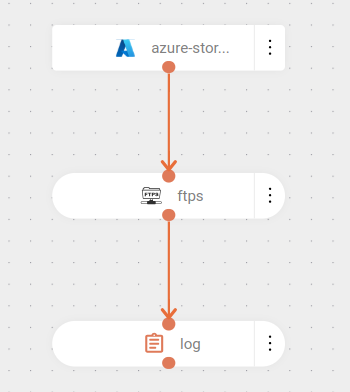
|
AWS S3 Storage Service
-
Description: the AWS S3 Storage Service component allows you to interact with the Amazon S3 service (Simple Storage Service) from AWS and manipulate data in S3 buckets directly through the integration routes.
-
Example
-
The flow is triggered by new events in an AWS S3 bucket (
aws2-s3://bucket-s3). -
The parameters specify the credentials used (stored in variables) and the bucket’s location.
-
Then, it logs a message with the content of the file or object processed from the bucket.
-
Script |
Diagram |
|
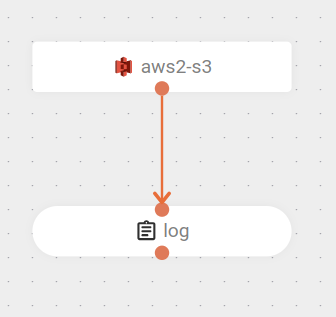
|
AWS Simple Queue Service (SQS)
-
Description: the AWS SQS component supports sending and receiving messages to and from Amazon’s SQS service.
-
Example
-
The flow retrieves messages from an AWS SQS queue. Access credentials (
accessKeyandsecretKey) allow the flow to authenticate with AWS. -
The received messages are logged at the
infolevel, enabling you to view the processed data.
-
Script |
Diagram |
|
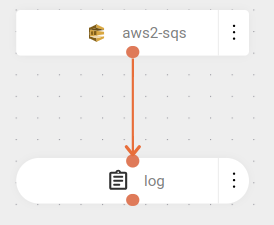
|
Cron
-
Description: the Cron component allows events to be triggered at specific time intervals.
-
Example
-
The snippet below sets up a cron trigger to fire every day at noon. Then logs a message.
-
Script |
Diagram |
|
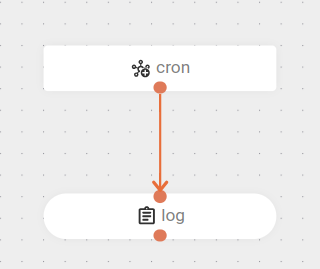
|
Cron Expression
A cron expression is a string consisting of 6 or 7 fields separated by whitespace. The fields can contain any allowed values along with various combinations of the special characters allowed for that field. The fields are as follows:
| Field Name | Required | Allowed Values | Allowed Special Characters |
|---|---|---|---|
Seconds |
YES |
0-59 |
, - * / |
Minutes |
YES |
0-59 |
, - * / |
Hours |
YES |
0-23 |
, - * / |
Day of Month |
YES |
1-31 |
, - * ? / L W |
Month |
YES |
1-12 or JAN-DEC |
, - * / |
Day of Week |
YES |
1-7 or SUN-SAT |
, - * ? / L # |
Year |
NO |
empty, 1970-2099 |
, - * / |
Meaning of the main special characters
| Special character | Meaning |
|---|---|
* |
All values for the field. |
? |
No specific value (used in "day of month" and "day of week" fields). Useful when you need to specify something in one of the two fields where the character is allowed, but not in the other. For example, if I want my trigger to fire on a specific day of the month (say, the 10th), but I don’t care which day of the week it is, I would put “10” in the day of the month field and “?” in the day of the week field. |
- |
Range of values (all values included in the range). |
, |
List separator for values (only the specified values). |
/ |
Incremental values. For example, “0/15” in the seconds field means “at seconds 0, 15, 30, and 45”. |
Examples
| Cron expression | Meaning |
|---|---|
0 0 12 * * ? |
Fires at 12 PM (noon) every day. |
0 15 10 * * ? 2005 |
Fires at 10:15 AM every day during the year 2005. |
0 15 10 15 * ? |
Fires at 10:15 AM on the 15th day of every month. |
For more information and examples, visit: Cron Trigger Tutorial.
Also check out Cron Expression Generator (Quartz).
| Support for specifying both "day of week" and "day of month" simultaneously is incomplete. Currently, you must use the '?' character in one of these fields. |
Fast Healthcare Interoperability Resources (FHIR)
-
Description: the FHIR component enables the standardized exchange of healthcare data between systems, ensuring interoperability and communication consistency. It defines a flexible structure based on resources, representing clinical, administrative, and financial entities, allowing standardized communication across different platforms.
-
Example
-
The integration starts with a search on a FHIR server that filters patients by the last name "Simpson".
-
After retrieving the data from the FHIR server, the response is sent to a REST endpoint.
-
The retrieved data is processed by the marshal EIP, ensuring the response is formatted in FHIR JSON.
-
The FHIR version used is R4.
-
Script |
Diagram |
|
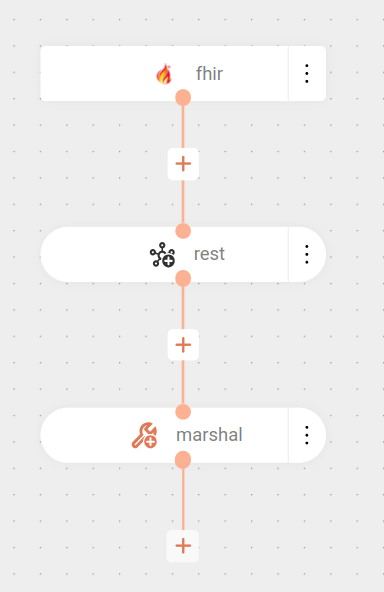
|
-
Guidelines for using the FHIR component
-
The component’s response will be placed in the body of the Exchange as a Java object.
-
The object varies depending on the API and protocol version used.
-
For the R4 version, the object will be in the package org.hl7.fhir.r4.model.
-
-
To use the object in other components, it must be converted to JSON using the EIP marshal.
-
Use the Data Format
fhirJson. -
The traditional JSON Data Format is not compatible with FHIR classes.
-
-
The component parameters do not support expressions to obtain a payload from the body.
-
To achieve this, use the inBody parameter.
-
-
Expressions cannot be used in just any field.
-
To parameterize values, use environment variables.
-
-
FTP/FTPS
-
Description: the FTP component provides access to remote file systems through FTP and SFTP protocols. It operates only in passive mode.
| FTPS is a secure version of FTP that adds support for SSL/TLS to encrypt the connection. |
-
Example
-
The flow connects to an FTP server and downloads text files.
-
The parameters indicate the credentials used for authentication (
usernameandpassword) and that it should filter and include only files with the.txtextension. -
The flow includes a delay of 10 seconds between download attempts and operates in passive mode.
-
Then, it logs the content of these files in a log.
-
Script |
Diagram |
|
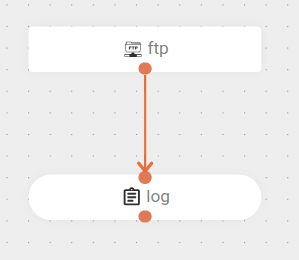
|
Google Pub/Sub
-
Description: The Google Pub/Sub component enables integration with the Google Cloud Pub/Sub service to publish and consume messages. It is ideal for asynchronous communication between applications, facilitating data exchange in distributed scenarios.
-
Example
-
A message is received from the
my-topictopic on Google Pub/Sub. -
The parameters include:
-
serviceAccountKey: JSON file of the service account used for authentication. -
destinationName: name of the topic on Google Pub/Sub.
-
-
The message body is transformed using the
simpleexpression. The text "Transformed message: " is added, and the content is converted to uppercase${body.toUpperCase()}. -
A log is recorded with the text "Message sent to Pub/Sub topic:" followed by the transformed message.
-
Script |
Diagram |
|
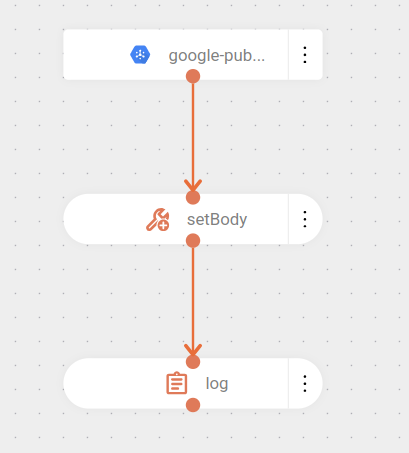
|
Google Storage
-
Description: the Google Storage component enables integration with the Google Cloud Storage service, facilitating the storage and retrieval of objects in Google Cloud buckets. It can be configured to download files from a bucket, allowing these files to be consumed and processed in Camel routes.
-
Example
-
The flow starts with Google Storage as the trigger.
-
It downloads a file.
-
Then, it sends a message to the log.
-
Script |
Diagram |
|
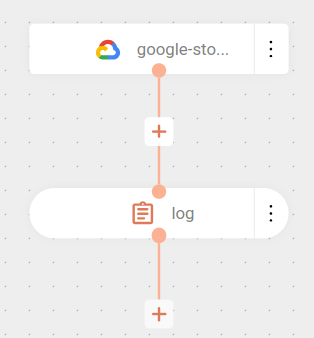
|
Kafka
-
Description: the Kafka component is used to communicate with the Apache Kafka message broker.
-
Example
-
The flow starts by receiving messages from the Kafka topic
my-topic, configured with the brokers settings. -
Then, the received message is logged for monitoring and debugging.
-
Script |
Diagram |
|
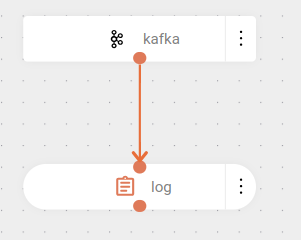
|
IMAP/IMAPS
-
Description: IMAP is a protocol used for receiving emails, allowing access to various mail folders and the manipulation of messages directly on the server.
IMAPS is a secure version of IMAP that transmits data encrypted using SSL/TLS. -
Example
-
The flow is configured to connect to an email account using the IMAP protocol on the Gmail server on port 993.
-
URI parameters:
-
The flow uses the provided credentials (
usernameandpassword) for authentication; -
It is configured not to delete emails (
delete=false); -
It is set to fetch only unread messages (
unseen=true); -
There is a delay of 60 seconds (
delay=60000), meaning it will check for new emails every minute.
-
-
When a new email is found, the full content of the email is logged.
-
Script |
Diagram |
|
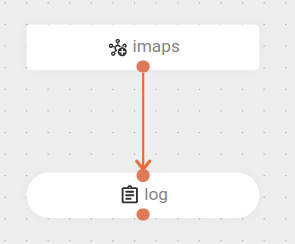
|
POP3/POP3S
-
Description: the POP3 component is used to retrieve emails from POP3 servers, allowing Camel to access the inbox, read the messages, and process them automatically in an integration flow.
| POP3S is a secure version of POP3 that transmits data encrypted using SSL/TLS. |
-
Example
-
The code shows a connection to an email server using the secure POP3 protocol (POP3S) to access a Gmail account.
-
URI parameters:
-
username=yourusername: username; -
password=yourpassword: password; -
delete=false: specifies that messages should not be deleted from the server after being read; -
unseen=true: indicates that only messages that have not yet been read should be retrieved; -
delay=60000: sets a 60-second delay between each attempt to retrieve new messages.
-
-
Script |
Diagram |
|
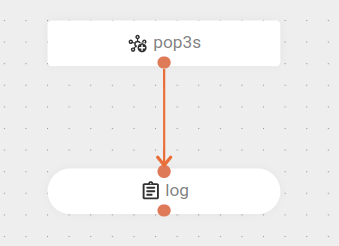
|
Paho
-
Description: the Paho component enables the integration of applications with the MQTT protocol, facilitating communication between devices and systems in Internet of Things (IoT) environments.
-
Example
-
The flow begins by subscribing to the
sensor/temperaturetopic on an MQTT broker, using a secure SSL connection at the URLbroker.brokername.com:8883. -
It logs a message with the received content:
Got message ${body}. -
If a message with the content
"Sensor data: 24°C"is published on thesensor/temperaturetopic, the log will record:"Got message Sensor data: 24°C".
-
Script |
Diagram |
|
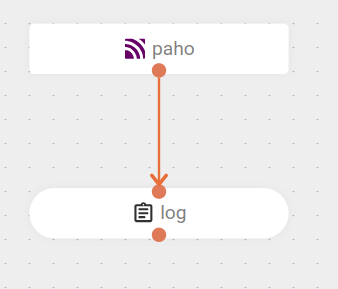
|
Paho MQTT5
-
Description: the Paho MQTT5 component enables the integration of applications with the MQTT protocol (version 5), offering advanced messaging features, such as persistent sessions and flow control.
-
Example
-
The flow is identical to the one described for the Paho component, except it uses version 5 of the MQTT protocol.
-
Script |
Diagram |
|
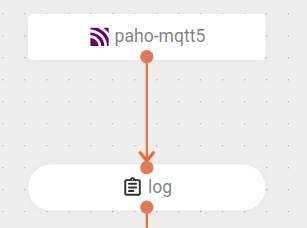
|
Quartz
-
Description: the Quartz component allows scheduling and triggering events based on cron expressions. It enables configuring tasks to be triggered at regular intervals, such as every minute, hour, or day, using standard cron syntax.
| See Cron trigger. |
-
Example
-
The flow is triggered every day at noon. Then a message is logged.
-
Script |
Diagram |
|

|
REST
-
Description: the REST component allows creating and managing RESTful endpoints, facilitating communication between applications via the HTTP protocol. It enables the definition of routes that respond to HTTP requests (such as
GET,POST,PUT, andDELETE), processing data, invoking services, and manipulating information. -
Example
-
The flow starts with a
POSTrequest to/demo. -
There are no additional parameters, indicating that the default endpoint settings will be used.
-
Then a test message is logged.
-
Script |
Diagram |
|
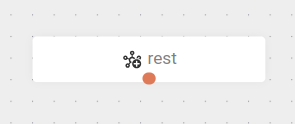
|
Scheduler
-
Description: the Scheduler component is used to generate message exchanges when a scheduler triggers.
-
Example
-
In the snippet below, the URI shows a scheduler named
mySchedulerName, which is triggered every 60 seconds. -
Then a test message is logged.
-
Script |
Diagram |
|
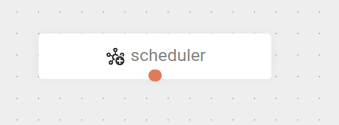
|
SFTP
-
Description: the SFTP component provides access to remote file systems using FTP and SFTP protocols. It operates in passive mode only.
-
Example
-
The flow reads
.txtfiles from a specified SFTP server, using a username and password for authentication. -
After the download, the content of the files is sent to a log for record-keeping.
-
Script |
Diagram |
|
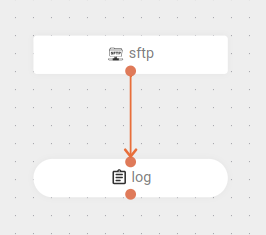
|
Slack
-
Description: the Slack component allows you to send messages, notifications, and alerts directly to Slack channels or users from your integration flows.
-
Example
-
The flow listens for messages in the specified Slack channel.
-
The Slack authentication token is included in the parameters.
-
When a message is received, it is captured and logged with its content.
-
Script |
Diagram |
|
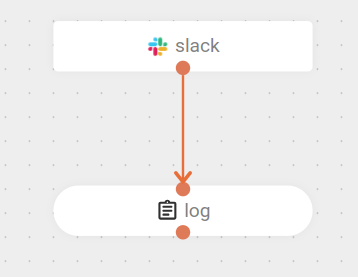
|
SMB
-
Description: the SMB component enables reading files from directories shared via the SMB/CIFS protocol, allowing ingestion of data from remote servers. You can configure:
-
SMB directory path: the location of the share to be monitored or read, for example:
smb://server/share/folder. (Common tab) -
Access credentials: authentication information such as username, password, and domain (when applicable). (Security tab)
-
Read filters: file extension, modification date, and minimum or maximum size.
The integration supports both continuous and scheduled file reading, and allows you to configure flow control parameters, acknowledgment, and post-processing deletion.
-
-
URI syntax:
smb:hostname:port/shareName -
Main fields
Path parameters
Name Description Default Type hostname(required) The hostname or IP address of the share.
-
String
portThe port number of the share.
445
int
shareName(required) The name of the shared directory.
-
String
Query parameters
Name Description Default Type password(security) The password to access the share.
-
String
username(security) The username required to access the share.
-
String
The Path query parameter, from the Common tab, is an optional field since Apache Camel version 4.8.0. -
Example
-
The flow monitors an SMB (Windows File Share) at
server-example, port445, on the sharemyshare. -
Access credentials are provided via the
usernameandpasswordparameters. -
The
path: "/"parameter means it monitors the root of the share. -
The
delay: 60000parameter makes the flow check for new files every 60 seconds (1 minute). -
When a file is found, it logs the file name and raw content (
${body}). -
Then, the message body is changed to the file’s
InputStream, allowing binary manipulation or content reading. -
Finally, another log records the file content (now as an InputStream).
The body generated by the consumer is of type com.hierynomus.smbj.share.File, which does not have native integration with Camel. Therefore, thegetInputStream()method is used to obtain the data stream for consumption.In short, this flow reads files from an SMB share every minute, logs the file name and content, and prepares the content for further processing.
-
Script |
Diagram |
|
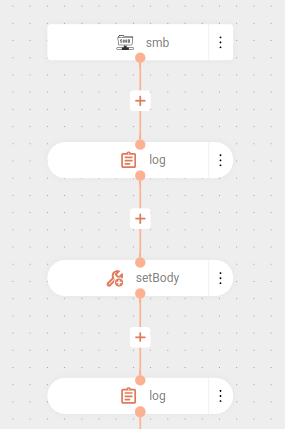
|
Timer
-
Description: the Timer component is used to generate message exchanges when a timer triggers.
-
Example
-
In the snippet below, the URI shows a timer named
mytimer, which is triggered every 30 seconds (30,000 milliseconds). -
Then a test message is logged.
-
Script |
Diagram |
|
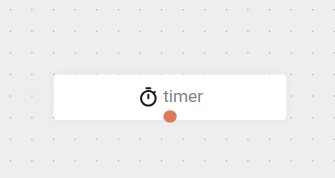
|
Share your suggestions with us!
Click here and then [+ Submit idea]









